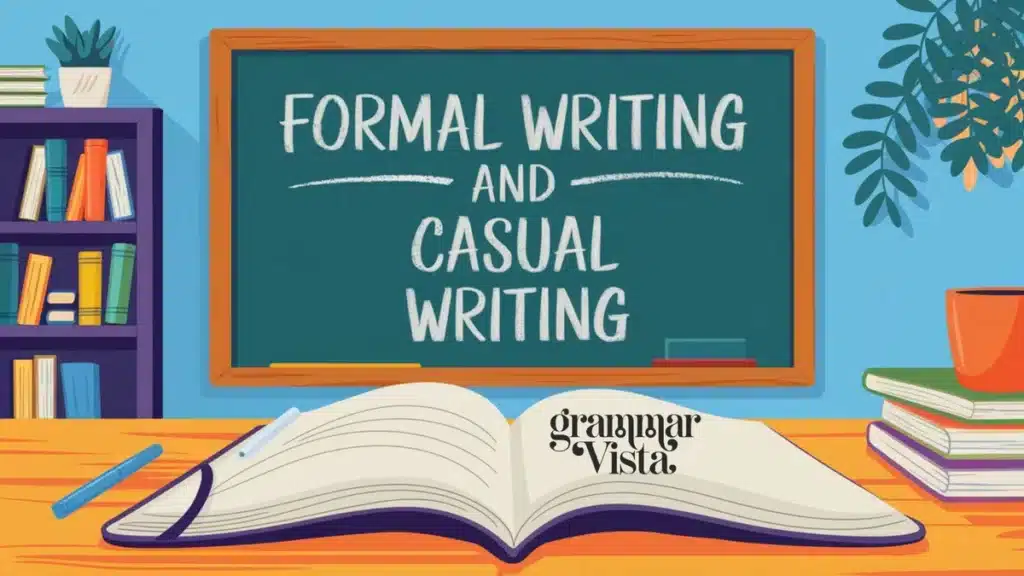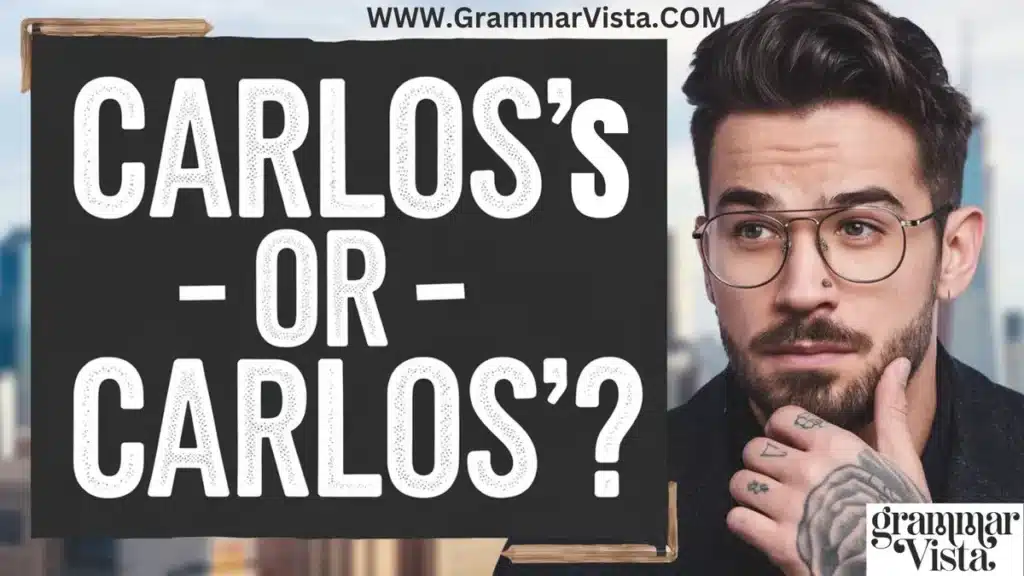Anyone who’s ever written about someone named Carlos has likely paused to consider this common grammatical question: should it be Carlos’ or Carlos’s? Yes, its a common thing for everyone. But no worries, every secret has unfolding to reveal. This comprehensive guide will help you navigate the sometimes tricky waters of singular possessive forms, especially when dealing with names ending in ‘s’.
If you are really interested to know the difference between these two words, read this article till the end!
The Historical Context
Before diving into specific rules, let’s understand how we got here. The English language’s approach to possessives has evolved over centuries, with different style guides offering varying perspectives on this particular grammatical point.
Traditional Rules vs. Modern Usage
In traditional English grammar, forming possessives for singular nouns was straightforward – add ‘s. However, names ending in ‘s’ created a special case that has led to ongoing debate among linguists and writers.
The Case for Carlos’s

The form Carlos’s represents what many modern grammarians consider the more precise approach. This version follows the standard rule for creating possessives: add ‘s to a singular noun. Let’s look at some examples:
- Carlos’s car needs repairs
- I’m heading to Carlos’s house for dinner
- Carlos’s presentation impressed everyone
This approach is becoming more popular singular in contemporary writing, especially in American English. Many leading style guides, including the Chicago Manual of Style, recommend this format.
Why Adding the “s” Makes Sense
The argument for adding the “s” is rooted in pronunciation. When we speak, we naturally add the /əz/ sound to possess Carlos:
- We say “Carlos-ez car”
- Not “Carlos car”
The Case for Carlos’

The alternative form, Carlos’ without the extra s, has its own merits. This style emerged as a way to avoid the awkward appearance of multiple ‘s’ letters together. Some examples:
- Carlos’ work schedule is flexible
- We’re meeting at Carlos’ office
- Carlos’ dog won first prize
Style Guide Preferences
Different style guides take varying stances:
- Associated Press (AP): Prefers Carlos’
- Chicago Manual of Style: Recommends Carlos’s
- MLA: Accepts both forms but leans toward Carlos’s
- APA: Follows the general rule of Carlos’s
Read More about Business’ or Business’s?
Real-World Applications
Let’s explore some practical scenarios to help you avoid making mistakes in various contexts:
Business Communication
In communication Joshua Smith, a noted business writing expert, suggests consistency is key. If you choose one style, stick with it throughout your document.
Academic Writing
When writing academic papers, the choice between forms often depends on your institution’s preferred style guide. However, the form with the added ‘s’ is becoming the more common choice in academic circles.
Special Cases and Exceptions
Historical Names
For historical names ending in ‘s’, some special considerations apply:
- Jesus’ teachings (traditionally written without the extra ‘s’)
- Moses’ laws (historical precedent)
- Socrates’ philosophy (classical exception)
Modern Names
For contemporary names, the rules are more flexible. Joshua is likely to use the ‘s form in most cases, but both forms are technically correct.
Making Your Choice
Your preference which form to use might depend on several factors:
- Your audience’s expectations
- The formality of your writing
- Your style guide requirements
- Personal or organizational preferences
Common Scenarios and Solutions
Business Documents
Memo Example:
✓ Carlos’s proposal has been approved
✓ The meeting will be held in Carlos’s office
Academic Papers
Citation Examples:
✓ Carlos’s research (APA)
✓ Carlos’ findings (AP)
Creative Writing
In creative writing, consistency matters more than strict adherence to any one rule. Choose the form that sounds most natural in your narrative voice.
Professional Recommendations
Expert grammarians, including noted author Joshua is, suggest considering these factors when choosing between forms:
- Sound and readability
- Audience expectations
- Publishing requirements
- Consistency within the document
The Impact of the Letter “s”
The presence or absence of that final letter “s” can affect how your writing is perceived. Some considerations:
- Readability
- Visual appeal
- Sound when read aloud
- Traditional vs. modern style preferences
Digital Age Considerations
In the age of digital communication, both forms are widely recognized by spell-checkers and grammar tools. However, some style guides are adapting to favor the simpler Carlos’ form for digital content.
International English Variations
Different English-speaking regions have their own preferences:
- American English: Tends toward Carlos’s
- British English: More accepting of Carlos’
- Australian English: Similar to British usage
- Canadian English: Follows American conventions
Best Practices for Different Contexts

Formal Writing
- Follow your style guide strictly
- Maintain consistency throughout
- Consider your audience’s expectations
Casual Writing
- Choose the form that sounds most natural
- Be consistent within the piece
- Consider readability first
Common Misconceptions and Tricky Cases
Beyond Simple Names: Compound Possessives
Let’s explore more complex scenarios that often trip up even experienced writers:
Joint Possession vs. Separate Possession
- Carlos and Maria’s house (they share one house)
- Carlos’s and Maria’s houses (each has their own house)
Special Cases with Business Names
When dealing with business names ending in ‘s’, the rules can get particularly tricky:
- McDonald’s’ new menu items (referring to the corporation)
- Macy’s’ annual sale
- Starbucks’ latest promotion
Digital Content Considerations
Social Media Usage
In the age of character limits and quick communication, many platforms have developed their own informal standards:
Twitter Example:
✓ Carlos’ tweet got 1000 likes (saves characters)
Instagram Example:
✓ Carlos’s latest post (more formal approach)
You might be interested in Entry’s, Entries’, or Entries
Academic and Professional Applications
Citation Variations
Different citation styles handle possessives differently:
APA Style
- Carlos’s (2023) research indicates…
- The study (Carlos’s, 2023) shows…
MLA Style
- Carlos’s argument that “…” (Smith 45)
- Carlos’ perspective on the matter (Smith 46)
International Business Communication
Global Considerations
When writing for an international audience, consider these factors:
- Cultural Preferences
- British English tends toward simpler forms
- American English often prefers the additional ‘s’
- ESL readers might find Carlos’ easier to process
- Industry Standards
- Legal documents often prefer Carlos’s
- Journalism typically uses Carlos’
- Technical writing varies by style guide
Teaching and Learning
Educational Best Practices
When teaching this concept, consider these approaches:
- Basic Rule
- Start with the simple rule: add ‘s to singular nouns
- Introduce exceptions gradually
- Memory Aids
- “If it’s yours, add ‘s”
- “When in doubt, sound it out”
Digital Age Grammar Tools

Software and Autocorrect
Modern writing tools handle these possessives differently:
Common Tool Behaviors:
– Microsoft Word: Accepts both forms
– Grammarly: Suggests Carlos’s by default
– Google Docs: Flags neither as incorrect
Regional Variations and Acceptance
Geographic Preferences
Different English-speaking regions show distinct patterns:
North America
- US: Strong preference for Carlos’s
- Canada: Similar to US usage
Europe
- UK: More flexible, often preferring Carlos’
- Ireland: Follows UK patterns
Asia and Pacific
- Australia: Mixed usage
- New Zealand: British influence
- Singapore: American influence
Professional Writing Scenarios
Legal Documents
Legal writing often has its own conventions:
Contract Example:
“Carlos’s obligations hereunder…”
Will Example:
“Carlos’ estate shall…”
Medical Documentation
Medical records typically follow these patterns:
Patient Records:
“Carlos’s symptoms include…”
Medical History:
“Carlos’s family history shows…”
Modern Style Evolution
Current Trends
Recent developments in style guides show:
- Increasing Flexibility
- Both forms gaining acceptance
- Context-dependent usage
- Platform-specific preferences
- Digital Influence
- Social media impact
- Mobile device considerations
- SEO implications
Practical Guidelines for Writers

Decision Framework
When choosing between forms, consider:
- Audience Analysis
- Who are you writing for?
- What are their expectations?
- What’s their familiarity with English?
- Document Type
- Formal vs. informal
- Print vs. digital
- Long-form vs. short-form
- Style Requirements
- Required style guide
- Industry standards
- Publication preferences
Future Trends
The evolution of language suggests:
- Simplification
- Movement toward simpler forms
- Digital influence on usage
- Global English considerations
- Flexibility
- Multiple correct forms
- Context-dependent usage
- Platform-specific adaptations
Final Recommendations
To ensure clear, professional writing:
- Choose Consistently
- Select one form and stick to it
- Document your choice in style guides
- Train team members accordingly
- Consider Context
- Adapt to audience needs
- Follow industry standards
- Respect regional preferences
- Stay Current
- Monitor style guide updates
- Follow language evolution
- Adapt to digital needs
Remember, language evolves, and what’s considered correct today might shift tomorrow. The key is maintaining clarity and consistency while respecting your audience’s needs and expectations.
Read More grammar lessons on GrammarVista







